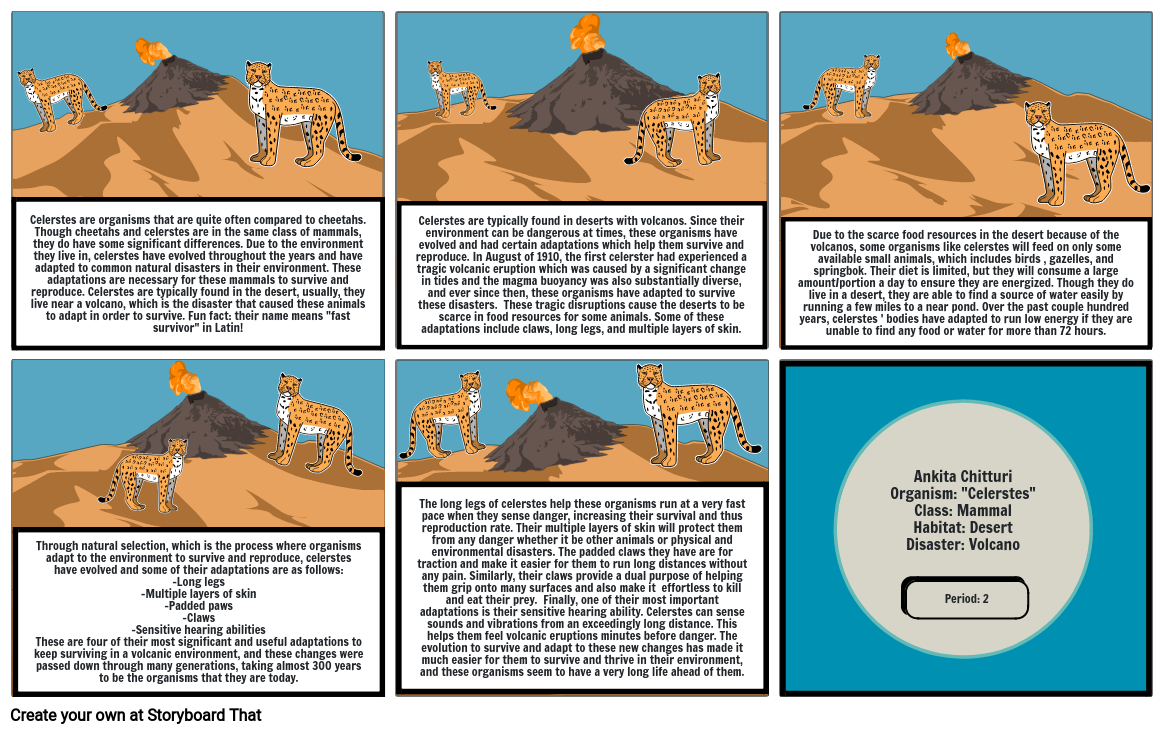Biology-Natural Selection Project

نص القصة المصورة
- Celerstes are organisms that are quite often compared to cheetahs. Though cheetahs and celerstes are in the same class of mammals, they do have some significant differences. Due to the environment they live in, celerstes have evolved throughout the years and have adapted to common natural disasters in their environment. These adaptations are necessary for these mammals to survive and reproduce. Celerstes are typically found in the desert, usually, they live near a volcano, which is the disaster that caused these animals to adapt in order to survive. Fun fact: their name means "fast survivor" in Latin!
- Celerstes are typically found in deserts with volcanos. Since their environment can be dangerous at times, these organisms have evolved and had certain adaptations which help them survive and reproduce. In August of 1910, the first celerster had experienced a tragic volcanic eruption which was caused by a significant change in tides and the magma buoyancy was also substantially diverse, and ever since then, these organisms have adapted to survive these disasters. These tragic disruptions cause the deserts to be scarce in food resources for some animals. Some of these adaptations include claws, long legs, and multiple layers of skin.
-
- Due to the scarce food resources in the desert because of the volcanos, some organisms like celerstes will feed on only some available small animals, which includes birds , gazelles, and springbok. Their diet is limited, but they will consume a large amount/portion a day to ensure they are energized. Though they do live in a desert, they are able to find a source of water easily by running a few miles to a near pond. Over the past couple hundred years, celerstes ' bodies have adapted to run low energy if they are unable to find any food or water for more than 72 hours.
- Through natural selection, which is the process where organisms adapt to the environment to survive and reproduce, celerstes have evolved and some of their adaptations are as follows:-Long legs-Multiple layers of skin-Padded paws-Claws-Sensitive hearing abilitiesThese are four of their most significant and useful adaptations to keep surviving in a volcanic environment, and these changes were passed down through many generations, taking almost 300 years to be the organisms that they are today.
- The long legs of celerstes help these organisms run at a very fast pace when they sense danger, increasing their survival and thus reproduction rate. Their multiple layers of skin will protect them from any danger whether it be other animals or physical and environmental disasters. The padded claws they have are for traction and make it easier for them to run long distances without any pain. Similarly, their claws provide a dual purpose of helping them grip onto many surfaces and also make it effortless to kill and eat their prey. Finally, one of their most important adaptations is their sensitive hearing ability. Celerstes can sense sounds and vibrations from an exceedingly long distance. This helps them feel volcanic eruptions minutes before danger. The evolution to survive and adapt to these new changes has made it much easier for them to survive and thrive in their environment, and these organisms seem to have a very long life ahead of them.
-
- Ankita ChitturiOrganism: "Celerstes"Class: MammalHabitat: DesertDisaster: Volcano
- Period: 2
تم إنشاء أكثر من 30 مليون من القصص المصورة

